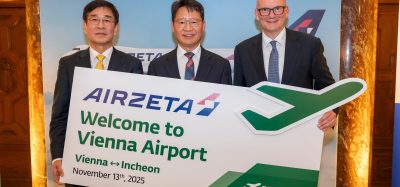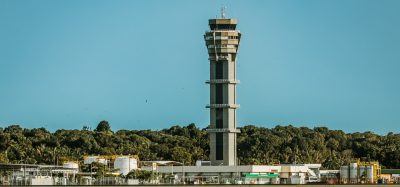Discussing the ambitions of London’s urban airport
Posted: 14 October 2019 | Tara Nolan (International Airport Review) | No comments yet
Tara Nolan, International Airport Review’s Editor, spoke to London City Airport’s Alison FitzGerald, Chief Operating Officer, and Liam McKay, Director of Corporate Affairs, regarding their mission to become the UK’s most sustainable airport.
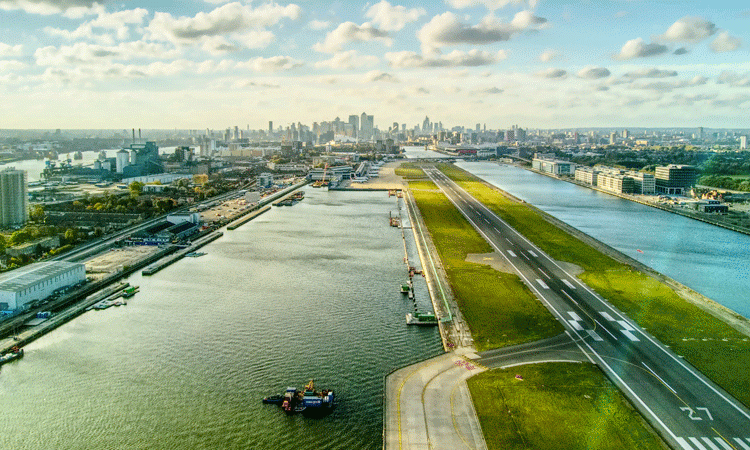

Sustainability within the future of airports has been widely discussed. But with 199 airports run by 40 operators in 24 European countries signing up to ACI’s recent pledge of being net zero for carbon emissions by 2050, many in the industry now have a deadline to stop discussing and start implementing change. One airport which has signed up to the pledge and isn’t concerned about hitting that deadline is London City Airport (LCY).
Going beyond core compliance
LCY has already reduced its carbon emissions by 30 per cent since 2013, while passenger numbers have risen by 42 per cent during that same time.
“Some people are hesitant about aligning themselves to a target,” said Alison FitzGerald, Chief Operating Officer at London City Airport. “But our agreement with ACI to be net zero by 2050 is completely right and we need to do it. We’re not putting our heads in the sand, we believe this enhances the proposition. It’s about change and making sure the airport is known for being something diff erent whilst aligned to passenger values.”
Join our free webinar: Revolutionising India’s travel experience through the Digi Yatra biometric programme.
Air travel is booming, and airports worldwide need to move passengers faster and more efficiently. Join the Digi Yatra Foundation and IDEMIA to discover how this groundbreaking initiative has already enabled over 60 million seamless domestic journeys using biometric identity management.
Date: 16 Dec | Time: 09:00 GMT
rEGISTER NOW TO SECURE YOUR SPOT
Can’t attend live? No worries – register to receive the recording post-event.
Not only is LCY confident that it will hit ACI’s target, it is keen to be at the forefront of this new sustainable era and has made broader changes within its business to do just that.
“It’s important that we set up our approach to sustainability in a wider context,” FitzGerald continued. “For environmental work and for corporate social responsibility work, we are currently under different teams, one that myself heads and one that Liam McKay heads. Our new approach is to align these teams to be under one roof and then align itself to the broader EU sustainable development goals.
“We go beyond what I would call ‘core compliance’. Not only do we accept challenges but embrace them as well.”
This can be seen in LCY’s dedication to not only making sure it employs locally, but that those employees are paid a fair wage (it has recently becoming a London Living Wage accredited employer, ensuring all employees and direct contractors are paid a minimum hourly wage of £10.55) and are encouraged to progress in their careers.
“We have challenges from local authorities on the percentage of local people we should employ and right now we’re at about 65 per cent,” Liam McKay, Director of Corporate Aff airs, explained. “Which in my eyes is an incredible track record. Not only do we bring people to work within the airport, but we give them a chance to evolve within the airport too. That has a great impact on the local economy and an example of how we go beyond compliance.”
Seeking input from the London community
This is very much a two-way street. Not only does LCY want to help its local community, it needs the next generation of that community to help the airport in its goal to be innovative and sustainable.
“To embrace a genuine ‘future of fl ight’ agenda we need to work with the next generation to come up with ideas,” McKay said. “Actually we want ideas from all over the place and in London in particular – it’s one of the most creative cities in the world and there may be people out there sitting on ideas that might be applicable. We’d love them to come forward.”
“We have an example of how we have done this very thing previously,” said FitzGerald. “It’s always been well known that London City Airport has a good passenger proposition from a speed point of view, but we didn’t know how quick we were, we had no way of measuring it. So, in partnership with Innovate UK, we held a competition, putting forward the challenge of measuring passenger throughput. We ended up in an alliance with a company called Crowd Vision, based in Greenwich, who developed the safety monitoring software for the Hajj pilgrimage [at Mecca].
“We started talking to the company about how we can adapt its software and it developed technology for us to measure our customer journey. We now know how many people we have at check-in and security, etc. and we can manage our queues accordingly. That started off with ‘we have a problem’ and we went out to the market with a competition which anyone could have responded to. In the end one of our previous shareholders invested in Crowd Vision and now the software is deployed globally.”
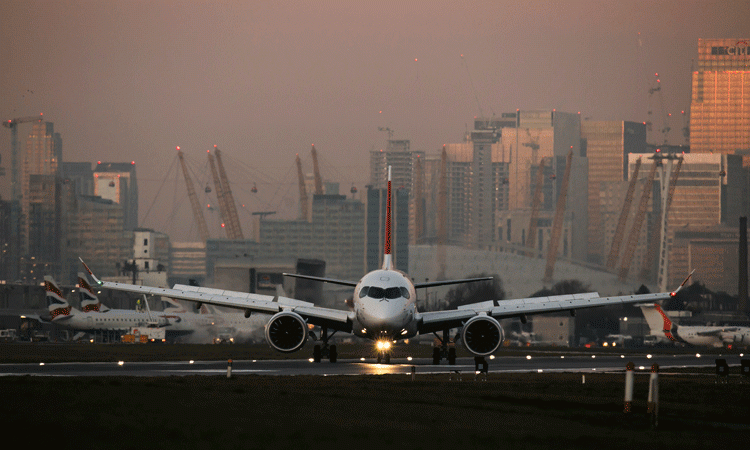

Utilising the urban location of London City
LCY’s location is fundamental to the airport, not only in regard to its local community but also in embracing London’s ideals as a whole. “This ‘future trend’ feels more applicable to us because of our size and the fact that we’re part of a city,” McKay enthused. “This is especially true with the city in question being London, which is part of the race to be the most innovative city in the world, and that’s something that’s also embraced here at London City Airport.”
Being an urban airport has meant that it has a natural focus on passengers and how they can sustainably get to and from the airport.
“The draft master plan’s ambition is to get 80 per cent surface access to and from the airport,” McKay explained. “We want to be quick and offer a range of different ways to get to the airport. We do have the DLR, but we want to focus on walking and cycling, because there’s tens of thousands of homes and offices being built around the airport and they’re all customers. They should be able to walk or cycle here.
“We want to take this further, so we’re looking at adding a platform to the DLR. At the moment, everyone steps out of the DLR in the same direction. But imagine a world where if you have hand luggage you step out on the other side and you’re straight into security and airside in 90 seconds.”
“For us, it’s about arriving and being security-ready,” added FitzGerald. “In the new development we won’t even have ‘check in’ anymore, we’ll just have a bag-drop area. We’re trying to cut out a lot of processes. So we’re looking at all the things you can do remotely – maybe we can get your bag picked up somewhere locally, or you can drop it off somewhere. Consolidating that bag process means we can get people here sooner and they’ll be more likely to come on public transport.”
However, as has already been established, LCY likes to go beyond compliance, and utilising its status as an urban airport goes beyond encouraging passengers to walk, cycle or take public transport.
“That agenda – the future of aviation and the hybrid agenda – is more possible here than many other UK airports because we fly shorter routes,” said McKay. “The sustainability agenda will be established first on shorter routes in the UK and EU short haul.”
“We’re already paving the way forward for innovations,” added FitzGerald. “Our digital air traffic control tower, for instance, lends itself to a different way for air traffic controllers to operate. Further to this, the opportunity is also there for urban traffic management. So, for instance, a lot of big cities have helicopters that are starting to be shared much like an Uber. What they’re looking at now is air traffic management that will operate below traditional aircrafts. Now how would you manage that without a digital traffic control tower? Some of the things we’re doing now makes us well placed to trial new initiatives and get involved in the development. We believe that this ecosystem needs to come together. It involves airports, air traffic management, airlines and manufacturers.”
Working directly with manufacturers
This ecosystem is another fundamental step in LCY’s drive in pushing the sustainability agenda, which it says is still some way off because there is a gap in what it needs to do and what it can do when it comes to equipment.
“In general, there’s a big lag of what we want to do and what we can do,” explained FitzGerald. “For example, we wanted to buy a new airfield sweeper but there’s nothing out there that’s fully electric for the size we need. The appetite is here but not necessarily available in the market yet. A similar principle applies to new aircraft, for now at least.”
Yet again, LCY’s location has ensured the airport has already met some of these challenges by working with manufacturers to create solutions.
“We have a unique operating configuration at this airport; our approach to the runway is five and a half degrees whilst typically it would be three. That affects the aircraft and how they land and how they take off. It means we work extremely closely with the aircraft manufacturers to complete the necessary certification work. These working relationships are ongoing and mean we are able to welcome the latest generation of cleaner, quieter aircraft, now and in the future.
“We worked with Airbus recently to qualify the A220-100 – previously known as the Bombardier C Series. We’ll also see the Embraer 190 E2 come in during 2020. It’s about working with aircraft manufacturers to see what they have in their fleet that we can modify to be able to land and take off here. It’s not straightforward for us but we’re investing, alongside the manufacturers, to get us to that more sustainable fleet. Our immediate goal is to scale up the numbers of new generation aircraft at the airport and then, further along, working with those providers to say ‘what can we do for the next level? What does the airport of the future look like?’”
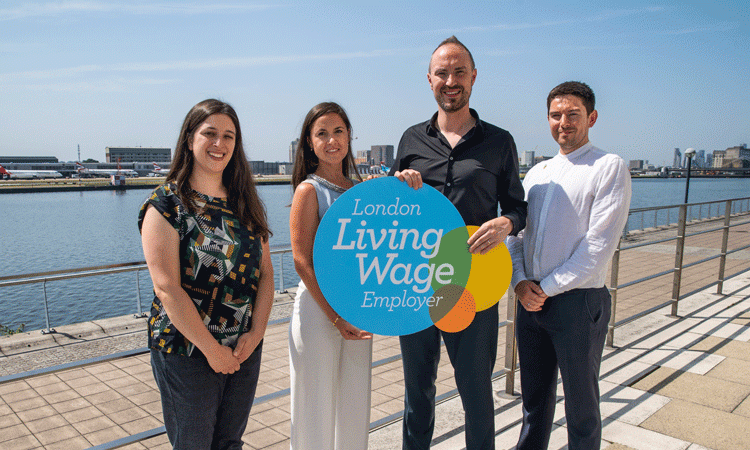

Liam McKay (third from left) promoting the London Living Wage
Broader industry challenge
But, as confident as LCY is on embracing the sustainability challenge, it knows the only way to create real change is for the aviation industry to work together.
“Sustainability is probably the most important issue for the industry at the moment,” said McKay. “There’s general public scepticism about sustainability but I think this is a broader industry challenge that we all have to get better at. We need to say ‘it can happen and here’s the road map to make that happen’. There’s a general challenge of making sure airports, manufacturers and airlines are aligned.”
This, McKay said, not only ensures the industry is more sustainable and aids the general world-wide goal of lowering emissions, but it’s also vital to the future of the industry.
“It’s important we don’t see a downturn of air travel because it’s not seen as the ‘right’ thing to be doing,” explained McKay. “We need to make sure air travel is still seen as something for the future, to make it more sustainable, so there isn’t a stigma.
“We won’t shift the dial without each other. Aviation is fundamental to our economy. We get that we need to change and innovate, and now it’s about embracing it collectively.
“We will get to net zero carbon emissions, but we’ll also need to work with other industries to be part of the next revolution of our industry. That’s what really matters.”
The International Airport Summit is open for registration!
Date: 19 – 20 November 2025
Location: JW Marriott Hotel Berlin
At our flagship event of the year, we will dive into the future of airport operations, with expert-led sessions on passenger experience, innovative smart technologies, baggage handling, airside operations, data, security, and sustainability.
This is where global airport leaders come together to share insights, challenges, and real-world solutions.
Limited complimentary passes are available for eligible professionals – first come, first served!
Issue
Related topics
Air traffic control/management (ATC/ATM), Airport development, Emissions, Sustainability, Sustainable development




